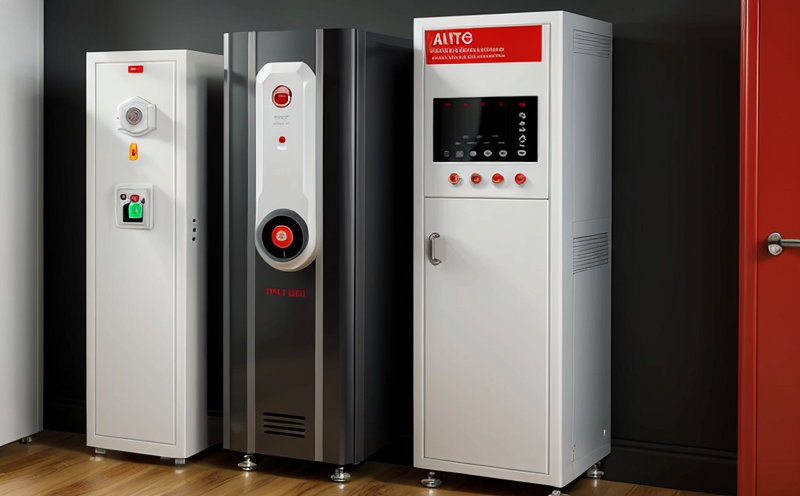EN 54-2 Control and Indicating Equipment Testing
The European Standard EN 54-2 governs the performance of control and indicating equipment for fire detection and alarm systems. This standard ensures that these devices meet stringent requirements to ensure they can accurately detect, signal, and provide information about fires in buildings. Testing according to this standard is essential for compliance with international regulations.
Control and indicating equipment form a critical part of any fire safety system, providing the interface between sensors and central control panels. The devices must be capable of receiving signals from various types of detectors, processing them correctly, and then relaying this information to alert personnel or trigger automatic suppression systems. Testing according to EN 54-2 ensures that these components function reliably under all conditions.
The testing process involves several key steps. Initially, the equipment is subjected to environmental stress tests such as temperature cycling, humidity exposure, and vibration. This helps identify any potential weaknesses in design or manufacturing processes before they become problematic during actual use. Afterward, functional tests are conducted to verify that each component operates correctly both individually and within integrated systems.
During the testing process, real-world scenarios such as smoke, heat, and fire are simulated using calibrated sources. The equipment's ability to respond appropriately is then evaluated based on its design specifications and performance criteria outlined in EN 54-2. Specific parameters include response time, sensitivity levels, and signal integrity.
Testing also covers the interaction between different parts of a fire alarm system. For instance, it checks how effectively signals travel from detectors to control units and subsequently to notification appliances like horns or strobes. Additionally, tests examine whether the equipment can handle multiple simultaneous inputs without causing false alarms or malfunctions.
Accurate documentation is crucial throughout this process. Detailed records are kept of all test procedures followed, environmental conditions during testing, observed results, and any discrepancies found against expected outcomes. These documents serve as evidence of compliance with EN 54-2 requirements and provide valuable insights for continuous improvement in product quality.
Compliance with EN 54-2 is mandatory for manufacturers wishing to sell their products within the European Economic Area (EEA). It ensures that all fire detection and alarm systems meet high standards of safety and reliability, thereby protecting lives and property from potential hazards. By adhering to this standard, businesses demonstrate their commitment to maintaining robust fire protection measures across various sectors including commercial buildings, industrial facilities, public venues, and residential complexes.
EN 54-2 testing plays a vital role in ensuring the effective functioning of control and indicating equipment used in fire safety systems. Through rigorous evaluation procedures focused on environmental resilience and operational accuracy, this standard helps maintain trust in the reliability of these critical components. As such, it serves as an essential foundation for safeguarding public safety against fire risks.
Scope and Methodology
The scope of EN 54-2 control and indicating equipment testing encompasses a wide range of devices designed to monitor, analyze, and respond to fire-related signals. This includes but is not limited to:
- Central units for automatic fire detection systems
- Distribution boards supplying power to detectors or other elements of the system
- Communication interfaces between various components
- Programming and configuration tools used by installers
The methodology employed during testing involves several stages aimed at verifying both individual component performance as well as overall system integrity. These stages typically include:
- Visual inspection to ensure proper assembly and labeling of components.
- Functional checks under controlled conditions simulating real-world usage scenarios.
- Environmental stress tests to assess durability against extreme temperatures, humidity levels, and mechanical shocks.
- Interconnected system testing to evaluate performance when multiple devices interact simultaneously within a larger network.
Why Choose This Test
Selecting EN 54-2 control and indicating equipment testing offers numerous advantages, particularly for organizations responsible for maintaining fire safety systems. One major benefit is the assurance that your products meet stringent international standards recognized globally. Compliance with these standards not only enhances credibility but also fosters trust among customers who rely on reliable fire protection solutions.
Another advantage lies in enhanced product quality through rigorous testing protocols designed to identify potential issues early in the development cycle. This proactive approach helps prevent costly rework or recalls later down the line, saving both time and resources while improving overall customer satisfaction.
In addition, EN 54-2 testing ensures compatibility between different components of a fire detection and alarm system. By validating that each part functions seamlessly with others, it promotes seamless integration across diverse environments ranging from small businesses to large-scale industrial operations. This interoperability reduces installation complexity and facilitates easier maintenance.
The standard also supports innovation by providing clear guidelines for manufacturers looking to introduce new features or improvements into existing products. With a well-defined framework in place, developers can focus on creating advanced solutions without worrying about conflicting requirements elsewhere. Furthermore, adherence to EN 54-2 fosters better collaboration among stakeholders involved in designing and implementing fire safety systems.
Lastly, choosing this test guarantees long-term reliability of your fire detection and alarm equipment. By subjecting them to exhaustive evaluations covering various aspects including environmental resilience and operational accuracy, you can rest assured that they will perform consistently over extended periods even under challenging circumstances. Such durability translates into significant savings in terms of reduced downtime and maintenance costs for end-users.
Customer Impact and Satisfaction
- Increased Confidence: Clients gain confidence knowing that their suppliers have met rigorous standards ensuring product quality and reliability.
- Better Decision-Making: Suppliers can make informed decisions based on comprehensive testing results, leading to improved product offerings.
- Enhanced Reputation: Compliance with EN 54-2 enhances the reputation of both suppliers and their clients, fostering stronger business relationships.
- Potential Cost Savings: By identifying defects early in the manufacturing process, there are fewer chances for costly recalls or repairs later on.





